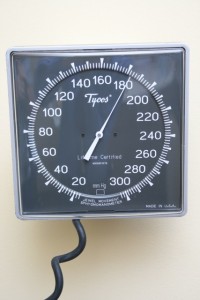 US medicine has long been accused of over-utilizing therapies with dubious clinical benefit — like imaging tests for back pain. Now add drug treatment of hypertension (high blood pressure) to that list, according to the conclusions of a highly respected evidence-based research group known as The Cochrane Collaboration.
US medicine has long been accused of over-utilizing therapies with dubious clinical benefit — like imaging tests for back pain. Now add drug treatment of hypertension (high blood pressure) to that list, according to the conclusions of a highly respected evidence-based research group known as The Cochrane Collaboration.
The Cochrane report has surprised many of us in primary care – especially since we’re the ones that usually diagnose and treat hypertension. My informal poll of several colleagues elicited responses of amazement (and some disbelief).
After all, under the auspices of the American Heart Association and the Joint National Committee on Hypertension – the two leading advisory bodies on high blood pressure — we’ve been trained that even stage 1 hypertension (140-159 systolic over 90-99 diastolic) deserves immediate attention. Patients in this category almost always receive medication.
Perhaps this is because these same advisory groups, along with our own federal government, for years have been making a big deal about pre-hypertension. If we’re expected to pay close attention to readings in the range of 120-139 systolic over 80-89 diastolic, then surely something higher warrants treatment, right?
Indeed, the new online high blood pressure calculator developed by the AHA concludes that patients with Stage 1 hypertension should “talk to your health professional… your doctor will probably prescribe medication to help lower your blood pressure.” Cynical visitors to the site will note that the only two corporate sponsors — Omron, which makes home blood pressure monitors, and Schering Plough, whose parent company Merck makes several antihypertensive medications — have much to gain from aggressive treatment of hypertension.
High blood pressure is not the only major lifestyle disease that has suffered from over diagnosis — the medical equivalent of “mission creep.” Drug companies have pushed hard to broaden the scope of many disease treatments to include individuals with mild symptoms, or none at all. This ensures the largest possible pool of patients to drive sales and, in turn, profits.
Take hypercholesterolemia and its main medication treatment, the statins. The first studies sponsored by pharmaceutical companies solicited sick patients – those who had already suffered heart attacks and had significant elevations of cholesterol. Result? Proven evidence that statin administration cuts the risk of subsequent heart attack and sudden death.
Over the next 20 years, drug companies spent billions of dollars on marketing and subsequent research to expand their clinical beachhead. Statin treatment has now been extended to individuals with relatively normal cholesterol and minimal risk factors — with supporting research sponsored by drug manufacturers.
But rooting out this low-level disease risk produces diminishing returns. Once again, The Cochrane Collaboration has taken aim at this practice, arguing that the benefit is so small as to make irrelevant the drug treatment of high cholesterol in individuals without underlying heart disease.
Similar arguments have been made with treatment of pre-diabetes – the glycemic no-man’s land between normal (fasting blood sugar of less than 100) and diabetes (fasting blood sugar above 125). While individuals with pre-diabetes have an increased risk of developing full-blown diabetes, treating them as diabetics (with medications to lower blood sugar) appears to offer no benefit and only creates needless risk of medication side effects.
And while modest treatment of diabetes is proven to reduce complications of this devastating disease, recent studies have revealed aggressive diabetic management to be risky, resulting in overall higher death rates even in those most likely to benefit (individuals with poorly controlled diabetes and risk factors for heart attack or stroke). The study evaluating this strategy (known as the ACCORD trial) was stopped early due to these severe complications.
That’s not to say that primary prevention is a lost cause. Modest daily exercise cuts risk of cardiovascular disease (heart attack or sudden death) by nearly half, and minimal weight loss and exercise in pre-diabetics can cut the risk of developing full-blown diabetes by about half also. But sadly, this non-pharmacologic, non-surgical approach is not the course that primary prevention typically follows. Usually we resort to a pill or procedure, either because it is more convenient for the patient, or the provider (or both).
There’s been a great deal of debate in this country over various strategies for health insurance coverage, but precious little regarding the efficacy and cost of various treatments. This is the next step in the evolution of our very flawed health care delivery system, and if readers thought that passage of the Affordable Care Act was a wrenching process, standardizing and validating the care that is provided under the Act will be magnitudes more disruptive.
As for me, while I’ve always encouraged exercise, diet, and weight loss as good adjuncts to drug treatment for hypertension, I’ll now have to place them front and center as first-line therapy, instead of medications. Wish me luck.
